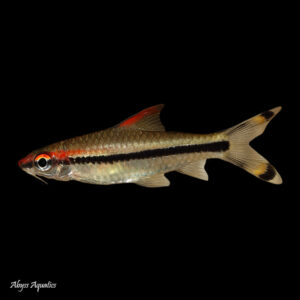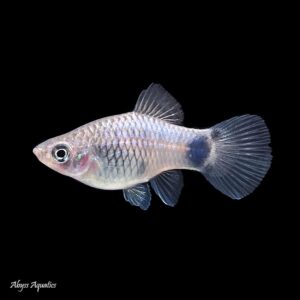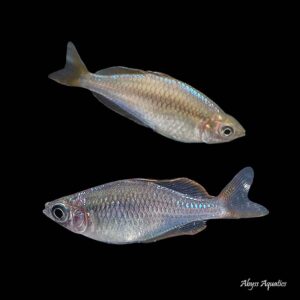The Green Neon Tetra (Paracheirodon simulans) is a small, vibrant fish known for its stunning appearance. Here is a detailed description of what a Green Neon Tetra looks like:
Body Shape: The Green Neon Tetra has a streamlined body shape typical of most tetras. It features an elongated and slightly laterally compressed body, tapering towards the rear.
Size: On average, the Green Neon Tetra reaches a maximum size of around 1 inch (2.5 centimeters) in length. They are relatively small fish, ideal for smaller aquarium setups.
Colouration: The body of the Green Neon Tetra is predominantly silver with a bright, neon green stripe that extends horizontally from the middle of the body to the base of the caudal fin (tail fin). The green stripe is highly vibrant and stands out against the silver background. The lower portion of the body has a silver-blue hue, adding to its overall beauty.
Fins: The dorsal fin, located on the back of the fish, is relatively small and has a transparent appearance. The anal fin, located on the ventral side, displays a similar transparent characteristic. The caudal fin is forked, with a combination of green and silver-blue hues, matching the body’s coloration.
Eyes: The Green Neon Tetra has large, round eyes with a black pupil. The eyes are positioned towards the front of the body, providing excellent vision for navigation and locating food.
Overall Appearance: The combination of the silver body, vibrant green stripe, and silver-blue lower body creates a striking contrast. When viewed under proper lighting, the Green Neon Tetra exhibits an iridescent shimmer, adding to its visual appeal.
The Green Neon Tetra’s colourful and eye-catching appearance makes it a popular choice among aquarium enthusiasts. Its small size and vibrant colouration can create a visually stunning display when kept in a group.
Green Neons Natural Habitat:
The Green Neon Tetra inhabits the densely vegetated areas of slow-moving streams, tributaries, and flooded forests found in South America. These water bodies are typically located in regions such as Brazil, Colombia, and Peru.
- Aquatic Vegetation: The fish would see an abundance of aquatic vegetation surrounding them. Thick growths of various plants, including floating plants, submerged plants, and marginal plants, provide shelter, hiding spots, and a sense of security. These plants offer protection from predators and serve as a source of food and habitat for small invertebrates and microorganisms.
- Dappled Light: Sunlight filters through the dense canopy of overhanging trees, creating dappled light patterns on the water’s surface. This natural lighting effect creates an enchanting atmosphere and plays a crucial role in the fish’s behaviour, signalling daytime and night-time cycles.
- Leaf Litter and Fallen Debris: Fallen leaves, twigs, and branches collect in the water, creating a layer of organic debris on the substrate. This layer provides additional hiding places for the fish and serves as a rich source of natural food, as it attracts microorganisms and small invertebrates.
- Water Currents: The water in their natural habitat flows gently, mimicking slow-moving streams or tributaries. The fish would experience a slight water current, helping to distribute nutrients and oxygen throughout the environment. These gentle currents also aid in the dispersion of eggs and fry during the breeding season.
- Biodiversity: The natural habitat of Green Neon Tetras is incredibly diverse. They would encounter various species of fish, both large and small, as well as a wide range of aquatic invertebrates, including crustaceans, snails, and insect larvae. The presence of such biodiversity contributes to the overall ecological balance and provides ample food sources for the fish.
In their natural habitat, Green Neon Tetras thrive in the presence of abundant vegetation, gentle water currents, dappled lighting, and a diverse ecosystem. The combination of these factors creates a harmonious and dynamic environment that supports their well-being and natural behaviours.
Our Green Neons are Tank Bred Heres Why:
- Tank-bred Green Neon Tetras (Paracheirodon simulans) are generally considered to be stronger and more resilient to diseases compared to their wild-caught counterparts. This is primarily due to the controlled breeding and rearing conditions they experience in aquarium settings. Here’s an explanation of why tank-bred neons are often hardier:
- Controlled Breeding: Tank-bred neons are bred in controlled environments, such as fish farms or breeding facilities. This allows breeders to carefully select healthy parent stock and control various breeding parameters, including water quality, nutrition, and genetics. By controlling these factors, breeders can produce offspring with improved genetic traits and overall robustness.
- Adaptation to Aquarium Life: Tank-bred neons are born and raised in an aquarium environment from the start. They are accustomed to the specific conditions found in aquariums, including water parameters, filtration systems, and artificial lighting. This early exposure helps them adapt better to captive conditions compared to wild-caught neons, which may experience stress during the transition from their natural habitat to an aquarium.
- Disease Resistance: Tank-bred neons often have better disease resistance due to reduced exposure to pathogens and parasites found in the wild. Breeders maintain strict hygiene protocols and provide optimal nutrition to the fish, minimizing the risk of diseases. Additionally, the controlled breeding process allows breeders to selectively breed for disease-resistant traits, enhancing the overall health and resilience of the offspring.
- Selective Breeding for Desired Traits: Tank-bred neons undergo selective breeding to enhance desirable traits, such as vibrant coloration, robustness, and improved overall health. Over generations of selective breeding, breeders can develop strains of neons that exhibit increased strength, adaptability, and disease resistance. This selective breeding process helps create a hardier and more resilient population of tank-bred neons.
- It is important to note that while tank-bred neons generally have a higher resistance to diseases and adapt better to aquarium life, proper care, maintenance of optimal water conditions, and regular monitoring are still essential for their well-being. By providing a suitable environment and meeting their specific care requirements, tank-bred Green Neon Tetras can thrive and bring beauty to aquarium setups.
Keeping Green Neon Tetra Healthy:
Keeping Green Neon Tetras healthy requires providing them with suitable water conditions and a well-maintained aquarium. They have a moderate care level and can be a bit delicate, requiring attention to water parameters, temperature, and quality. Maintaining stable water parameters, including temperature, pH, and hardness, is crucial for their well-being.
Special Requirements and Feeding:
Green Neon Tetras are omnivorous and have a diet that includes small live or frozen foods, high-quality flake or pellet foods, as well as small insects and larvae. They appreciate a varied diet to ensure proper nutrition. It’s important to provide them with a well-balanced diet and ensure that their nutritional needs are met.
How Many Green Neon Tetras Should I Keep?
Green Neon Tetras are shoaling fish and should be kept in groups of at least six individuals or more. By keeping them in a group, they feel more secure, display their natural behaviour, and are generally happier and healthier.
Lighting Preference:
Green Neon Tetras prefer moderate lighting levels in the aquarium. Providing appropriate lighting helps create a natural environment and enhances the visibility of their vibrant green and blue colours.
Suitable Tank Mates:
Green Neon Tetras are peaceful community fish that can coexist with other small, peaceful species. Good tank mates include other small tetras, rasboras, dwarf cichlids, and peaceful bottom-dwelling species like Corydoras catfish. It’s essential to avoid aggressive or fin-nipping species that may harm them.
Breeding Green Neon Tetra:
Breeding Green Neon Tetras (Paracheirodon Simulans) can be a challenging but rewarding endeavour. Here is a detailed description of the breeding process:
- Separate Breeding Tank: Prepare a separate breeding tank with suitable conditions to encourage spawning. The tank should be well-maintained and free from any potential threats or predators. It is recommended to use a tank size of at least 10 to 20 gallons (38 to 76 litres) to provide enough space for the breeding pair.
- Water Parameters: Green Neon Tetras prefer slightly acidic and soft water conditions for breeding. Aim for a pH range of 6.0 to 6.5 and a temperature around 77 to 82°F (25 to 28°C). It is important to maintain stable water parameters to create a conducive environment for spawning.
- Conditioning the Breeding Pair: Select a healthy male and female pair of Green Neon Tetras for breeding. To enhance their breeding readiness, provide them with a nutritious and varied diet consisting of live or frozen foods such as small insects, brine shrimp, and daphnia. Conditioning the fish with high-quality foods for a few weeks can improve their reproductive capabilities.
- Introduce the Breeding Pair: Place the conditioned male and female together in the breeding tank. Provide ample hiding places with fine-leaved plants, spawning mops, or mesh traps where the female can deposit her eggs. Adding some marbles or a mesh at the bottom of the tank can prevent the adult fish from eating the eggs.
- Inducing Spawning: To trigger spawning, simulate the rainy season by performing a slight drop in temperature or a partial water change with slightly cooler water. You can also adjust the lighting period to imitate natural conditions. Maintaining dim lighting during the day and increasing it during the early morning or evening can help stimulate spawning behaviour.
- Egg Deposition: The female will scatter adhesive eggs among the fine-leaved plants or spawning mops. The male will then fertilize the eggs by releasing milt over them. After spawning, it is recommended to remove the adult fish from the breeding tank to prevent them from eating the eggs.
- Incubation and Hatching: The eggs are transparent and will adhere to the surfaces they are deposited on. They require approximately 24 to 36 hours to hatch, depending on the water temperature. Ensure a clean and well-aerated environment to promote healthy egg development. It’s important to monitor water conditions and remove any unfertilized or fungus-infected eggs promptly to prevent contamination.
- Fry Care: Once the eggs hatch, the fry will initially feed on their yolk sacs. After a few days, they will become free-swimming and require tiny, nutritious food such as infusoria, baby brine shrimp, or commercial liquid fry food. Provide regular, small feedings to ensure their proper growth and development.
Breeding Green Neon Tetras can be challenging due to their specific requirements and the delicate nature of their eggs and fry. Patience, attention to detail, and maintaining optimal water conditions are essential for successful breeding. With proper care and a conducive breeding environment, you can enjoy the fascinating process of raising new generations of these beautiful fish.
Sexual Dimorphism:
Male Green Neon Tetras tend to have brighter and more intense colours compared to females. Males typically display a more vibrant green and blue coloration, while females may appear slightly duller.
Lifespan:
With proper care, Green Neon Tetras can live for approximately 3 to 5 years, although individual lifespans may vary.
Distribution:
Green Neon Tetras are native to the blackwater streams and rivers of South America, specifically the upper Rio Negro region in Brazil and Colombia. They occur naturally in these areas and have also been successfully bred in captivity.
Summary:
The Green Neon Tetra is a small, colourful freshwater fish with a maximum size of around 1 inch. It originates from the blackwater streams and rivers of South America and requires proper care to thrive in aquariums. They are a bit delicate in terms of their care level, requiring attention to water parameters, suitable tank mates, and a balanced diet. By providing them with a well-maintained tank, appropriate lighting, and suitable companions, you can enjoy





James Harding –
Never bought green neons before and i wasn’t sure what to expect, what stunning fish! As were all of the fish that abyss sent me. I also appreciate the sweets in the box haha Thankyou Abyss!
Tommy Brown (verified owner) –
Ordered 15 of these beautiful fish to go along with the 11 I’ve got. They look absolutely stunning. Arrived in great condition, very happy!